Maya In the News ...
Portal to Maya Underworld Found in Mexico?National Geographic -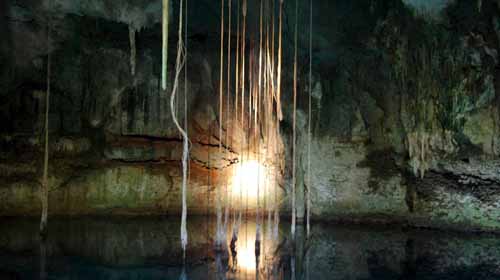
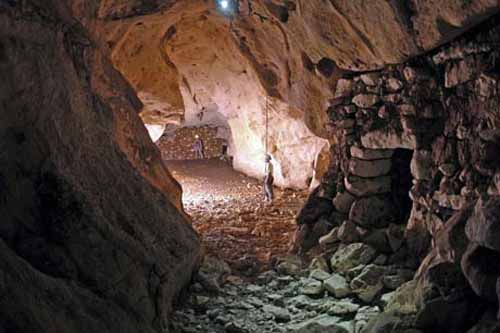
- Mexican archeologists have discovered a maze of stone temples in underground caves, some submerged in water and containing human bones, which ancient Mayans believed was a portal where dead souls entered the underworld. Clad in scuba gear and edging through narrow tunnels, researchers discovered the stone ruins of eleven sacred temples and what could be the remains of human sacrifices at the site in the Yucatan Peninsula.
Archeologists say Mayans believed the underground complex of water-filled caves leading into dry chambers -- including an underground road stretching some 330 feet -- was the path to a mythical underworld, known as Xibalba.
According to an ancient Mayan scripture, the Popol Vuh, the route was filled with obstacles, including rivers filled with scorpions, blood and pus and houses shrouded in darkness or swarming with shrieking bats, Guillermo de Anda, one of the lead investigators at the site. "The souls of the dead followed a mythical dog who could see at night," de Anda said.
Excavations over the past five months in the Yucatan caves revealed stone carvings and pottery left for the dead. "They believed that this place was the entrance to Xibalba. That is why we have found the offerings there," de Anda said. The Mayans built soaring pyramids and elaborate palaces in Central America and southern Mexico before mysteriously abandoning their cities around 900 A.D. They described the torturous journey to Xibalba in the Popul Vuh sacred text, originally written in hieroglyphic script on long scrolls and later transcribed by Spanish conquerors. "It is very likely this area was protected as a sacred depository for the dead or for the passage of their souls," said de Anda, whose team has found ceramic offerings along with bones in some temples.
Different Mayan groups who inhabited southern Mexico and northern Guatemala and Belize had their own entrances to the underworld which archeologists have discovered at other sites, almost always in cave systems buried deep in the jungle. In the Yucatan site they have found one 1,900-year-old ceramic vase, but most of the artifacts date back to between 700 and 850 A.D. "These sacred tunnels and caves were natural temples and annexes to temples on the surface," said de Anda.
Secret to Mayan Blue Paint FoundLive Science - February 26, 2008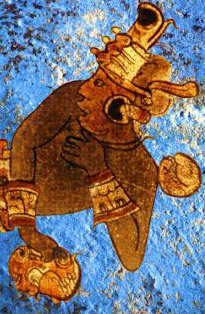
Mysteries of "Sacrificial" Maya Blue Pigment Solved? National Geographic - February 26, 2008
Ancient Mayans: Temples for Everyone! National Geographic - February 26, 2008 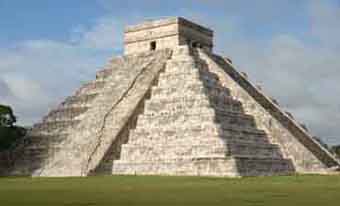
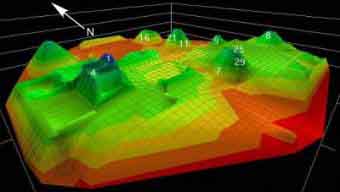
Guatemala: Spy Satellite Spots Lost Mayan Cities AOL - February 21, 2008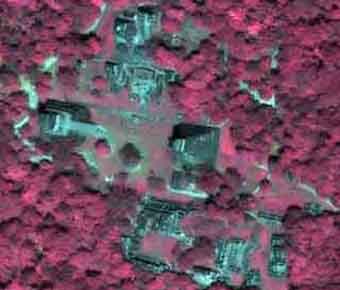
- Guatemala City: Ancient Mayan astronomers aligned their soaring temples with the stars and now modern archeologists have found the ruins of hidden cities in the Guatemalan jungle by peering down from space.
Archaeologists investigating the collapse of the Mayan civilization said Wednesday that they used a satellite to uncover the ruins of hidden cities in the Guatemalan jungle. The satellite can see through clouds and forests to reveal differences in the vegetation below. The image above was colored to help highlight patterns of jungle growth.
Archeologists and NASA scientists began teaming up five years ago to search for clues about the mysterious collapse of the Mayan civilization that flourished in Central America and southern Mexico for 1,000 years. The work is paying off, says archeologist William Saturno, who recently discovered five sprawling sites with hundreds of buildings using a spy satellite that can see through clouds and forest to reveal differences in the vegetation below. Saturno said the satellite images made it infinitely easier to find ruins covered for centuries by dense jungle vines and trees.
Saturno first sought out satellite images to find a source of water near his excavation camp at San Bartolo, which lies 32 miles from the nearest town on inaccessible roads deep in Guatemala's northern Peten region. NASA gave him a snapshot of solar radiation reflected off the wide variety of plants in the region. Saturno was surprised to see a pattern of discoloration in the satellite image that outlined some of the buildings he had already uncovered. Using a GPS device, he pinpointed on a map the location of other discolorations nearby and discovered several areas with hidden Mayan architecture.
The Maya built with limestone and lime plasters. As the abandoned buildings disintegrate, chemicals from the stones seep into the soil, keeping some plants from growing around the structures and affecting the chemistry of those that do grow. The satellite can spot these differences and the result is a virtual road map of the buried structures from nearly 400 miles above Earth's surface.
Saturno said he expects more discoveries like his 2001 find of an elaborate mural from around 100 B.C. depicting the Mayan creation myth, dubbed the Sistine Chapel of the Mayan world. His research partner at NASA, Tom Sever, hopes the satellite images could provide clues as to why the Mayan civilization collapsed around 900 A.D. "What we are investigating is the choices the Maya made that ultimately created a catastrophic situation for them," Sever said by telephone from a NASA base in the U.S. state of Alabama.
To support a population boom the Maya felled huge swathes of jungle for agriculture. They collected water in giant reservoirs called "bajos" to farm during seasonal dry spells, but the deforestation raised temperatures and reduced rainfall, drying up water sources, Sever said. Bajos were found at around half the new sites located by the satellite, potentially boosting this theory of why the Maya had to leave their cities. Information about the fate of the Maya could help modern societies make better choices and avoid the sometimes disastrous mistakes of the past.
Ancient Maya Used "Glitter" Paint to Make Temple Gleam National Geographic - February 7, 2008
Ancient Mayan Marketplace Discovered National Geographic - December 5, 2007
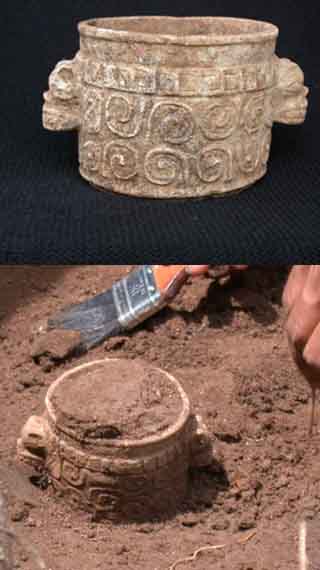
Rare Maya "Death Vase" Discovered National Geographic - December 3, 2007
Maya Rituals Caused Ancient Decline in Big Game National Geographic - November 15, 2007
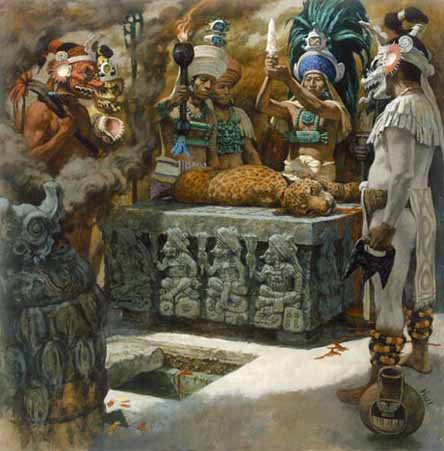
Ancient Mexicans and Egyptians who never met and lived centuries and thousands of miles apart both worshiped feathered-serpent deities, built pyramidsand developed a 365-day calendar, a new exhibition shows. Billed as the world's largest temporary archeological showcase, Mexican archeologists have brought treasures from ancient Egypt to display alongside the great indigenous civilizations of Mexico for the first time.
The exhibition, which boasts a five-tonne, 3,000-year-old sculpture of Egyptian pharaoh Ramses II and stone carvings from Mexican pyramid at Chichen Itza,aims to show many of the similarities of two complex worlds both conquered by Europeans in invasions 1,500 years apart. "There are huge cultural parallels between ancient Egypt and Mexico in religion, astronomy, architecture and the arts. They deserve to be appreciated together," said exhibition organizer Gina Ulloa, who spent almost three years preparing the 35,520 square-feet (3,300 meter-square) display.
The exhibition, which opened at the weekend in the northern Mexican city of Monterrey, shows how Mexican civilizations worshiped the feathered snake Quetzalcoatlfrom about 1,200 BC to 1521, when the Spanish conquered Aztecs. From 3,000 BC onward Egyptians often portrayed their gods, including the Goddess of the Pharaohs Isis, in art and sculpture as serpents with wings or feathers. The feathered serpent and the serpent alongside a deity signifies the duality of human existence, at once in touch with water and earth, the serpent, and the heavens, the feathers of a bird," said Ulloa. Egyptian sculptures at the exhibition -- flown to Mexico from ancient temples along the Nile and from museums in Cairo, Luxor and Alexandria - show how Isis' son Horuswas often represented with winged arms and accompanied by serpents. Cleopatra, the last Egyptian queen before the Roman conquest of Egypt in 30 BC, saw herself as Isis and wore a gold serpent in her headpiece.
Uncanny Similarities
In the arts, Mexico's earliest civilization, Olmecs, echo Egypt'sfinest sculptures. Olmec artists carved large man-jaguar warriors that are similar to the Egyptian sphinxes on display showing lions with the heads of gods or kings. The seated statue of an Egyptian scribe carved between 2465 and 2323 BC shows stonework and attention to detail that parallels a seated stone sculpture of an Olmec lord. There is no evidence the Olmecs and Egyptians ever met.
Shared traits run to architecture, with Egyptians building pyramids as royal tombs and the Mayans and Aztecs following suit with pyramids as places of sacrifice to the gods. While there isno room for pyramids at the exhibition -- part of the Universal Forum of Cultures, an international cultural festival held in Barcelona in 2004 -- organizers say it is the first time many of pieces have left Egypt. They include entire archways from Nile temples, a bracelet worn by Ramses II and sarcophagi used by the pharaohs. Mexico has also brought together Aztec, Mayan and Olmec pieces from across the country.
Ancient Farm Discovery Yields Clues to Maya Diet National Geographic - August 20, 2007
World's Longest Underground River Discovered in Mexico, Divers Say National Geographic - March 6, 2007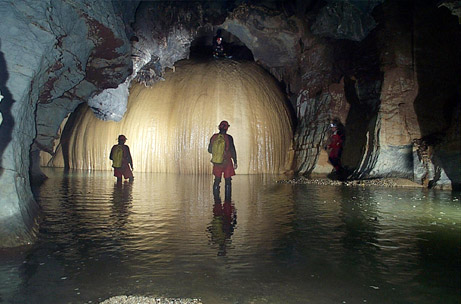
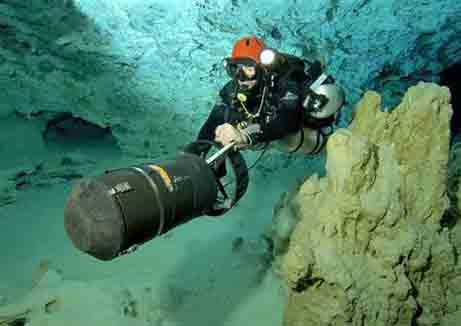
German diver Robbie Schmittner is seen diving with a propulsion device through an underwater cave system in the Yucatan peninsula, Mexico। Bogaerts says he and Schmittner found flooded underground passages connecting two previously known caves, a discovery that could constitute the world's longest underwater cave system, showing how vulnerable the Yucatan's fabled underground water system is.
Priceless Maya Stone Vessel Looted in Guatemala National Geographic - May 7, 2006
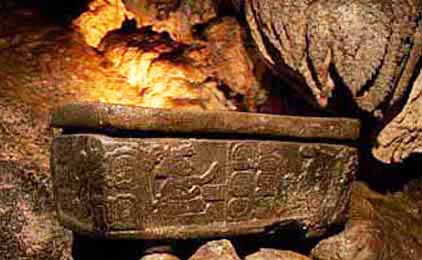
Carved from volcanic rock and covered in intricate hieroglyphs, the vessel is only the fourth of its kind to emerge from the so-called Maya rain forest of Central America. Dating to A.D. 480 to 550, the box is a rare example of lowland Maya art from the murky Early Classic period, Woodfill says. Symbolic figures and characters - including the god of the underworld, a scribe, and another artisan - adorn four sides of the box.
Ancient Maya Royal Tomb Discovered in GuatemalaNational Geographic - May 4, 2006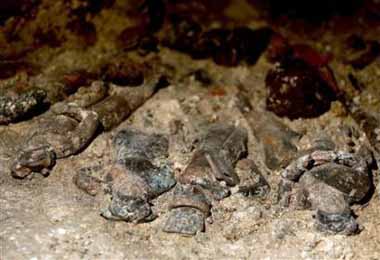
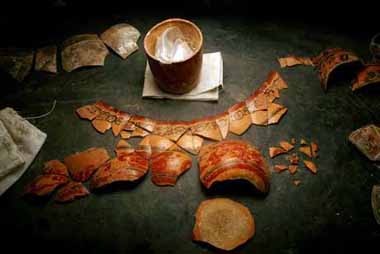
Archeologists outsmarted tomb raiders to unearth a major Maya Indian royal burial site in the Guatemalan jungle, discovering jade jewelry and a jaguar pelt from more than 1,500 years ago.
Priceless Maya Stone Vessel Looted in Guatemala National Geographic - May 7, 2006
Mayan hieroglyphics discovered dating to 3rd century BCNational Geographic - January 6, 2006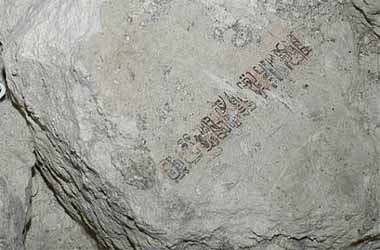
Earliest Maya Writing Found in Guatemala
Earliest Mayan writing found in pyramid MSNBC - January 6, 2006
Ancient Portrait of Maya Woman Found - Who Was She? National Geographic - December 8, 2005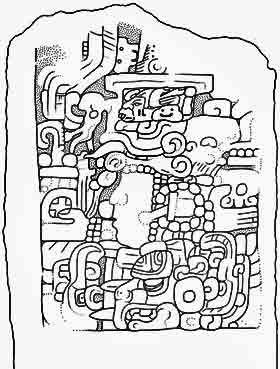
Early Mayan women were a powerful force News in Science - December 6, 2005
Mass Graves Reveal Massacre of Maya Royalty National Geographic - November 18, 2005
Maya culture 'ahead of its time' BBC -May 2004
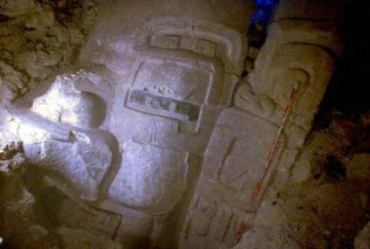
Giant masks reveal early Maya sophistication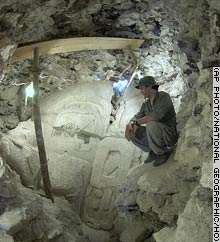
Archaeologist Francisco Estrada-Belli is dwarfed by the enormous stucco face of a Maya deity at a little-known site in Guatemala called Cival.
Archaeologists Uncover Maya "Masterpiece" in GuatemalaNational Geographic - April 2004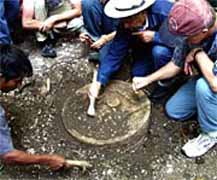
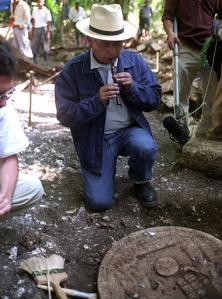
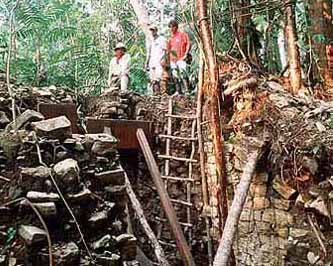
Archaeologists working deep in Guatemala's rain forest under the protection of armed guards say they have unearthed one of the greatest Maya art masterpieces ever found. The artifact - a 100-pound (45-kilogram) stone panel carved with images and hieroglyphics - depicts Taj Chan Ahk, the mighty 8th-century king of the ancient Maya city-state of Cancuén - excavation of royal mayan palace.
Ancient Nicaraguan society foundBBC - May 2003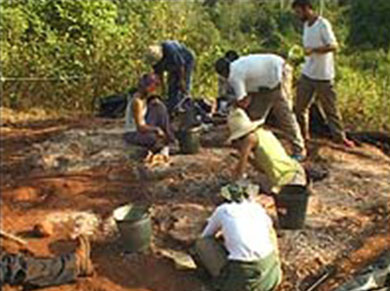
Archaeologists discover a previously unknown ancient Pre-Mayan civilisation in Central America that developed around 2,700 years ago and lasted for a thousand years.
New Discovery in PalenqueMesoweb.com - October 10, 2002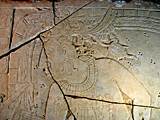
... just south of the Cross Group - a stone tablet with an elaborate scene and numerous hieroglyphs carved in relief was found on the side of a low platform in Temple XXI. It now joins the canon of historically vital and stunningly beautiful monuments from this Classic Maya site in Chiapas, Mexico.
Openings to the Underworld News in Science - May 18, 2002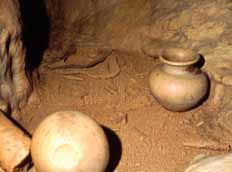
he ancient Maya may have dug caves with spiritual abandon
Jade 'mother lode' found in remote Guatemalan regionSan Francisco Gate - May 2002
May 29, 2001 - Reuters - Tegucigalpa, Honduras
The jade-encrusted remains of a powerful Mayan king have been unearthed in Honduras by a Japanese archeologist in a key finding from the ancient and mysterious civilization, the tourism ministry said on Friday. The remains belong to one of the 16 rulers of the Mayan dynasty that ruled the city of Copan, in what is now Honduras, between 426 and 763 A.D., the ministry said. Archeologist Seiichi Nakamura, who made the discovery, said the king may have served between the 6th and 10th regimes of the Copan dynasty.
The tomb contained a skull, a femur and an ornamental breastplate and kneecap with jade inlays. It was dug up in August but was only recently confirmed to hold the remains of a Mayan king. The discovery means that the remains of eight of Mayan's 16 rulers of Myan have now been found. The burial site was located at a religious temple that lies among ruins stretching across some 214,000 square feet. Some 20 recoverable buildings, 36 skeletal remains, 10 religious offerings, 37 ceramic vessels and other objects were also found at the site. The newly uncovered area is about 2 miles from the acropolis of Copan, where the Honduras government is constructing a highway. The Mayan culture sprung up in the region spanning southern Mexico, Belize, Guatemala, El Salvador and Honduras and is renowned for its imposing edifices, social organization, astrological advances and the existence of a calendar. Archeologists and scientists still do not fully understand the causes of the civilization's decline. The Mayan ruins in Honduras are among the impoverished nation's most visited tourist attractions.
May 2002 - San Francisco Gate
For half a century, scholars have searched in vain for the source of the jade that the early civilizations of the Americas prized above all else and fashioned into precious objects of worship, trade and adornment.
The searchers found some clues to the source of jadeite, as the precious rock is known, for the Olmecs and Mayas. But no lost mines came to light.
Now, scientists exploring the wilds of Guatemala say they have found the mother lode -- a mountainous region roughly the size of Rhode Island strewn with huge jade boulders, other rocky treasures and signs of ancient mining. It was discovered after a hurricane tore through the landscape and exposed the veins of jade, some of which turned up in stores, arousing the curiosity of scientists.
The find includes large outcroppings of blue jade, the gemstone of the Olmecs, the mysterious people who created the first complex culture in pre- Columbian Mesoamerica, the region that encompasses much of Mexico and Central America. It also includes an ancient mile-high road of stone that runs for miles through the densely forested region.
The deposits rival the world's leading source of mined jade today, in Burma, the experts say.
The implications for history, archaeology and anthropology are just starting to emerge.
For one thing, the scientists say, the find suggests that the Olmecs, who flourished on the southern Gulf Coast of Mexico, exerted wide influence in the Guatemalan highlands as well. All told, they add, the Guatemalan lode was worked for millenniums, compared with centuries for the Burmese one.
In part, the discovery is a result of the devastating storm that hit Central America in 1998, killing thousands of people and touching off floods and landslides that exposed old veins and washed jade into river beds. Local prospectors picked up the precious scraps, which found their way into Guatemalan jewelry shops and, eventually, the hands of astonished scientists.
Led by Seitz and local jade hunters, a team of scientists from the American Museum of Natural History, Rice University and UC Riverside scoured the forested ravines of the Guatemalan highlands for more than two years.
In the end the scientists made a series of discoveries culminating in bus- size boulders of Olmec blue jade. The exact locations of the outcroppings are not being given, to protect them.
Early peoples of the Americas considered jade more valuable than gold and silver. The Olmecs, the great sculptors of the pre-Columbian era, carved jades into delicate human forms and scary masks. Maya kings and other royalty often went to their graves with jade suits, rings and necklaces. The living had their teeth inlaid with the colored gems.